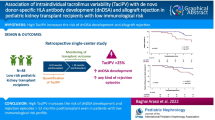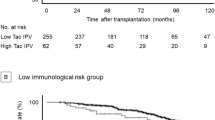Abstract
Background
Late acute cellular rejection (LACR) is associated with poorer graft outcomes and non-adherence. Non-adherence to tacrolimus can be indirectly assessed by the intra-patient variability (IPV) of tacrolimus trough levels. The threshold of IPV associated with rejection is not known.
Methods
We conducted a case-control study comparing 25 patients with biopsy-proven LACR against 25 stable controls matched for age group, primary diagnosis and time post-transplant. IPV was calculated using coefficient of variance (CV) and mean absolute deviation (MAD) using tacrolimus levels in the preceding 12 months. We also assessed the percentage time for tacrolimus levels < 4 μg/L (Tac < 4) and the concentration/weight-adjusted dose (C/D) ratio as a proxy marker of tacrolimus metaboliser status.
Results
LACR patients had higher CV (median, IQR 44%, 36–61% v. 24%, 19–35%, p < 0.0001) and higher MAD (33%, 25–48% v. 19%, 15–26%, p < 0.0001). The MAD was less affected by outlying tacrolimus results. Receiver operating curve analysis of the MAD resulted in a sensitivity of 76% and specificity of 76% at a threshold of 26% (AUC 0.85, p < 0.05). LACR patients had more Tac < 4 (50% v. 26%, p < 0.05). There was no difference in C/D suggesting that good IPV can be maintained in fast metabolisers. Patients with LACR had significantly increased creatinine at 12-month follow-up despite treatment (108 v. 5 umol/L increase from baseline) and four patients lost their allograft.
Conclusions
Monitoring of tacrolimus IPV using the MAD may be a clinical marker for LACR. A threshold IPV of 26% can potentially be used as a therapeutic target pending further validation studies.




Similar content being viewed by others
References
Emmes Corporation. 2014 Annual Transplant Report. Collab Stud NAPRTCS 2014;102
Eid L, Tuchman S, Moudgil A (2014) Late acute rejection: incidence, risk factors, and effect on graft survival and function. Pediatr Transplant 18(2):155–162
Pollock-Barziv SM, Finkelstein Y, Manlhiot C, Dipchand AI, Hebert D, Ng VL et al (2010) Variability in tacrolimus blood levels increases the risk of late rejection and graft loss after solid organ transplantation in older children. Pediatr Transplant 14(8):968–975
Wiebe C, Gibson IW, Blydt-Hansen TD, Karpinski M, Ho J, Storsley LJ et al (2012) Evolution and clinical pathologic correlations of de novo donor-specific HLA antibody post kidney transplant. Am J Transplant 12(5):1157–1167
Hricik DE, Formica RN, Nickerson P, Rush D, Fairchild RL, Poggio ED, et al. Adverse outcomes of tacrolimus withdrawal in immune–quiescent kidney transplant recipients. 2015;3114–3122
Prytuła A, van Gelder T (2018) Clinical aspects of tacrolimus use in paediatric renal transplant recipients. Pediatr Nephrol:1–13
Wiebe C, Rush DN, Nevins TE, Birk PE, Blydt-Hansen T, Gibson IW et al (2017) Class II Eplet mismatch modulates tacrolimus trough levels required to prevent donor-specific antibody development. J Am Soc Nephrol 28:1–10
Shuker N, van Gelder T, Hesselink DA (2015) Intra-patient variability in tacrolimus exposure: causes, consequences for clinical management. Transplant Rev (Orlando) 29(2):78–84
Laskow DA, Vincenti F, Neylan JF, Mendez R, Matas AJ (1996) An open-label, concentration-ranging trial of FK506 in primary kidney transplantation: a report of the United States Multicenter FK506 Kidney Transplant Group. Transplantation. 62(7):900–905
Ekberg H, Tedesco-Silva H, Demirbas A, Vítko Š, Nashan B, Gürkan A et al (2007) Reduced exposure to calcineurin inhibitors in renal transplantation. N Engl J Med 357(25):2562–2575
Grenda R, Watson A, Vondrak K, Webb NJA, Beattie J, Fitzpatrick M et al (2006) A prospective, randomized, multicenter trial of tacrolimus-based therapy with or without basiliximab in pediatric renal transplantation. Am J Transplant 6(7):1666–1672
Opelz G. CTS Collaborative Transplant Study Newsletter 1 : 2014. 2014;5–8
Pizzo HP, Ettenger RB, Gjertson DW, Reed EF, Zhang J, Gritsch HA et al (2016) Sirolimus and tacrolimus coefficient of variation is associated with rejection, donor-specific antibodies, and nonadherence. Pediatr Nephrol 31(12):2345–2352
Wallemacq PE, Verbeeck RK (2001) Comparative clinical pharmacokinetics of tacrolimus in paediatric and adult patients. Clin Pharmacokinet 40(4):283–295
Pallet N, Etienne I, Buchler M, Bailly E, Hurault de Ligny B, Choukroun G et al (2016) Long-term clinical impact of adaptation of initial tacrolimus dosing to CYP3A5 genotype. Am J Transplant 16(9):2670–2675
Shuker N, Bouamar R, Van Schaik RH, Clahsen-van Groningen MC, Damman J, Baan CC et al (2016) A randomized controlled trial comparing the efficacy of Cyp3a5 genotype-based with body- weight-based tacrolimus dosing after living donor kidney transplantation. Am J Transplant 16:2085–2096
Kim JJ, Balasubramanian R, Michaelides G, Wittenhagen P, Sebire NJ, Mamode N, et al. The clinical spectrum of de novo donor-specific antibodies in pediatric renal transplant recipients. 2014;2350–2358
Borra LCP, Roodnat JI, Kal JA, Mathot RAA, Weimar W, van Gelder T (2010) High within-patient variability in the clearance of tacrolimus is a risk factor for poor long-term outcome after kidney transplantation. Nephrol Dial Transplant 25(8):2757–2763
Shuker N, Shuker L, van Rosmalen J, Roodnat JI, Borra LCP, Weimar W et al (2016) A high intrapatient variability in tacrolimus exposure is associated with poor long-term outcome of kidney transplantation. Transpl Int 29(11):1158–1167
Prytula AA, Bouts AH, Mathot RAA, Van Gelder T, Croes LK, Hop W et al (2012) Intra-patient variability in tacrolimus trough concentrations and renal function decline in pediatric renal transplant recipients. Pediatr Transplant 16(6):613–618
Author information
Authors and Affiliations
Corresponding author
Additional information
Publisher’s note
Springer Nature remains neutral with regard to jurisdictional claims in published maps and institutional affiliations.
Electronic supplementary material
ESM 1
(DOCX 32 kb)
Rights and permissions
About this article
Cite this article
Abu Bakar, K., Mohamad, N.A., Hodi, Z. et al. Defining a threshold for tacrolimus intra-patient variability associated with late acute cellular rejection in paediatric kidney transplant recipients. Pediatr Nephrol 34, 2557–2562 (2019). https://doi.org/10.1007/s00467-019-04346-z
Received:
Revised:
Accepted:
Published:
Issue Date:
DOI: https://doi.org/10.1007/s00467-019-04346-z




